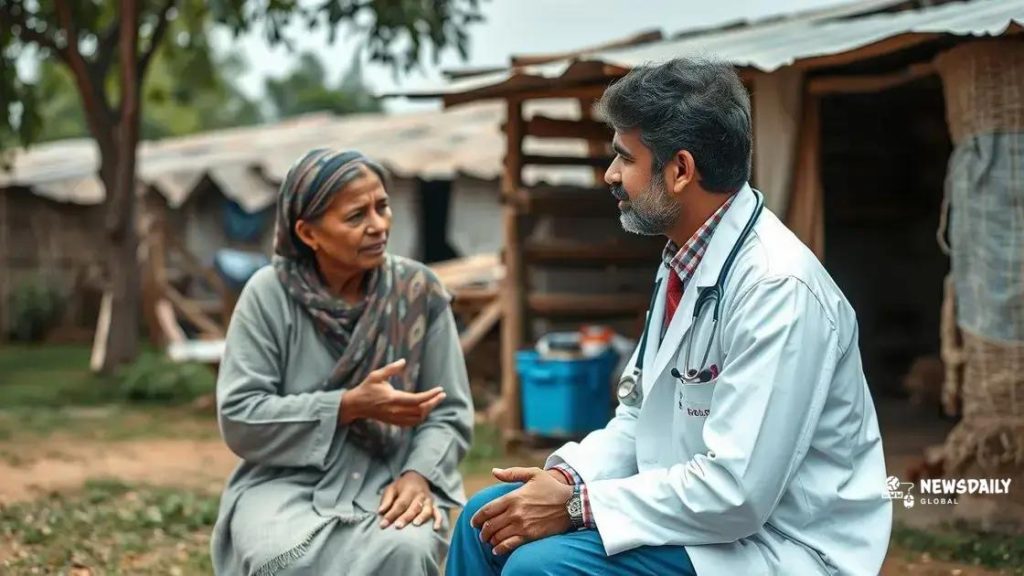Healthcare access in rural areas: challenges and innovations

Healthcare access in rural areas is significantly improved through telemedicine, community engagement, and innovative solutions that address geographic, educational, and financial barriers.
Healthcare access in rural areas is often a complex issue, affecting countless individuals. Have you ever wondered how these communities cope with limited resources and services? Let’s dive into the challenges and innovations shaping their future.
Understanding healthcare disparities in rural areas
Understanding healthcare disparities in rural areas is vital to improving overall health outcomes. Many rural communities face unique challenges that affect their access to essential services.
One significant issue is the lack of healthcare facilities. Rural areas often have fewer hospitals and clinics than urban regions. This can lead to long travel distances for patients seeking care, which can deter them from attending appointments.
Barriers to Access
Another factor is the shortage of healthcare professionals. Many healthcare providers prefer to work in urban settings, leading to limited options for rural residents. This not only restricts access but also impacts the quality of care given.
- Limited availability of specialists.
- Higher rates of uninsured individuals.
- Transportation challenges for patients.
Additionally, social determinants of health play a crucial role. Factors such as income level, education, and access to transportation can all influence healthcare access in these communities. For instance, those with lower incomes may struggle to afford necessary treatments or travel to distant clinics.
Technology’s Impact
Innovations in technology are making a difference. Telehealth services have become a vital resource, providing patients with access to care without the need for travel. This is particularly important for chronic disease management and mental health services.
Moreover, implementing community health programs can enhance awareness about preventive care and available healthcare services. Programs that educate residents about nutrition, exercise, and disease prevention can significantly improve health outcomes by fostering a healthier population.
Barriers to healthcare access for rural populations
Barriers to healthcare access for rural populations are significant obstacles that can severely impact health outcomes. These barriers stem from various factors that complicate the delivery of and access to care for those living in rural areas.
One primary challenge is the geographic isolation of many rural communities. Patients often need to travel long distances to reach healthcare facilities, making it difficult for them to seek timely medical attention. This isolation can also lead to delayed diagnoses and worse health outcomes.
Healthcare Provider Shortages
Another important issue is the shortage of healthcare providers in these regions. Many healthcare professionals choose to practice in urban settings, leaving rural areas underserved. This lack of professionals can lead to longer wait times, reduced patient care quality, and fewer available specialists.
- Fewer hospitals and clinics in rural areas.
- Limited access to specialists, such as cardiologists or neurologists.
- Aging workforce and insufficient new healthcare providers.
Additionally, financial constraints can prevent individuals from accessing necessary healthcare services. Many residents in rural areas may lack health insurance or have high out-of-pocket expenses, leading to missed appointments and insufficient preventative care.
Transportation Challenges
Transportation is another critical barrier for rural populations. Without reliable public transportation, many patients struggle to reach healthcare providers, especially for follow-up visits. This can cause ongoing health issues that might have been resolved with proper care.
Social factors also play a role in healthcare access. For example, individuals with lower levels of education may not fully understand the importance of preventive care, contributing to overall health disparities. Furthermore, cultural beliefs can influence healthcare-seeking behaviors, making it essential to engage with these communities to foster trust.
Innovative solutions improving healthcare access

Innovative solutions improving healthcare access are essential for addressing the disparities faced by rural populations. These solutions are designed to bridge the gap in care and ensure that everyone can receive the healthcare they need.
One major approach is the use of telemedicine. Telemedicine allows patients to consult with healthcare providers through video calls or phone calls. This technology is particularly beneficial for those who live far from healthcare facilities, as it reduces travel time and costs.
Community Outreach Programs
Community outreach programs play a crucial role in educating residents about available healthcare services. These programs can inform individuals about preventive care options and resources in their area.
- Health fairs offering free screenings and check-ups.
- Mobile clinics providing on-site medical services.
- Support groups addressing specific health issues.
Another innovative solution is leveraging mobile health applications. Mobile apps can help patients manage their health by providing appointment reminders and medication management tools. These apps can also connect users with healthcare professionals for advice and support.
Collaboration with Local Organizations
Partnerships with local organizations can enhance healthcare access as well. By collaborating with schools, churches, and non-profits, healthcare providers can reach more individuals and promote health education. This collaborative approach increases community trust and encourages residents to seek care without hesitance.
Investments in infrastructure, such as developing new clinics or upgrading existing ones, are vital as well. Ensuring that facilities are equipped with necessary technology can significantly improve service delivery. Focus on training healthcare workers to understand rural health challenges also contributes to better overall care.
Telemedicine’s role in rural healthcare
Telemedicine’s role in rural healthcare has become increasingly significant in recent years. It offers a unique solution to the challenges faced by rural populations who may struggle to access traditional healthcare services.
With telemedicine, patients in remote areas can connect with healthcare professionals without needing to travel long distances. This approach not only saves time and money but also makes it easier for patients to seek help when they need it. Many have experienced a significant improvement in managing chronic conditions through these remote consultations.
Benefits of Telemedicine
One of the primary advantages of telemedicine is its ability to provide immediate access to medical advice. Patients can schedule appointments quickly, often on short notice, and receive timely care. This is especially important for urgent medical needs where delays can lead to more severe health issues.
- Greater flexibility in scheduling appointments.
- Access to specialists who may not be available locally.
- Reduced cost of travel for patients.
Additionally, telemedicine improves patient engagement. Patients who use telehealth services often feel more empowered to take charge of their health. They can communicate more freely with their healthcare providers, leading to stronger patient-provider relationships.
Challenges and Considerations
Despite its advantages, telemedicine has some challenges, particularly in rural areas. Limited internet access can hinder the effectiveness of virtual visits. Not all patients have the necessary technology or stable internet connections to participate in telehealth services.
Moreover, some individuals may prefer face-to-face interactions and feel unsure about the quality of care provided online. It’s essential for healthcare providers to offer support and guidance to help patients feel comfortable with using telemedicine.
Community engagement strategies for better health outcomes
Community engagement strategies for better health outcomes are vital in addressing healthcare disparities, especially in rural areas. These strategies help involve local residents in health-related decision-making and promote healthier living.
One effective approach is to implement health education programs within communities. These programs can teach residents about nutrition, exercise, and disease prevention. By raising awareness about preventive measures, individuals may take proactive steps towards maintaining their health.
Building Partnerships
Building partnerships with local organizations can enhance community health efforts. Schools, churches, and non-profits can provide resources and support for health initiatives. Collaborating with these groups allows for a wider reach and fosters trust within the community.
- Engaging local leaders to promote health initiatives.
- Hosting workshops and seminars focused on health literacy.
- Creating community gardens to encourage healthy eating.
An additional strategy involves utilizing peer support programs. These programs help connect individuals with similar health challenges, fostering a sense of belonging and motivation. When people share their experiences, they can encourage one another and share valuable tips for managing their health.
Leveraging Technology
Technology can also play a significant role in community engagement. Social media platforms and mobile apps can be used to disseminate health information quickly. These channels allow health organizations to reach more individuals and facilitate discussions about health-related topics.
Moreover, organizing community events, like health fairs, can provide free screenings and resources to residents. These events not only promote health but also create an opportunity for community members to connect and support each other.
FAQ – Questions about Healthcare Access in Rural Areas
What is telemedicine?
Telemedicine is a way for patients to consult with healthcare providers remotely using technology, like video calls or phone calls.
How can community engagement improve health outcomes?
Community engagement fosters local involvement in health initiatives, which enhances awareness and encourages healthier behaviors.
What are some innovative solutions for healthcare access?
Innovative solutions include telehealth services, mobile health apps, and community outreach programs that educate residents about healthcare options.
Why is transportation a barrier to healthcare in rural areas?
Transportation is a barrier because many patients in rural areas may not have easy access to reliable transportation, making it difficult to reach healthcare facilities.






